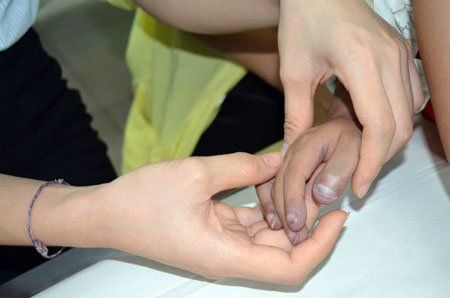This is an automatically translated article.
The article was professionally consulted with Master, Doctor Tran Hong Nhat - Interventional Cardiologist - Cardiovascular Center - Vinmec Central Park International General Hospital.Pulmonary stenosis surgery is a temporary treatment used to treat certain congenital heart diseases with severe pulmonary hypertension. The goal is to reduce blood flow to the lungs, avoid fixed pulmonary arterial hypertension, and also to prepare for total repair surgery.
1. Indications for pulmonary artery stenosis surgery in congenital heart disease
1.1. Heart disease group with left-right shunt and increased blood flow to the pulmonary artery
One or more ventricular septal defects and coarctation of the aorta or aortic arch atrophy. Univentricular or tricuspid atrophy and pulmonary arterial flow in the neonate. Atrioventricular canal with left ventricular insufficiency and high risk for total biventricular repair. Congenital heart diseases requiring homograft such as inversion of the artery with subvalvular stenosis require Rastelli surgery . Cardiovascular disease. Scrap windows - master.1.2. Group of patients with arterial inversion prepare for total repair surgery
Inversion of the arterial origin in infants older than 1 month of age. Inversion of the artery in a child who has undergone Mustard or Senning surgery with right ventricular failure. Inversion of the artery in a child with a small left ventricle prepares for total repair.
2. Contraindications
Pulmonary stenosis surgery is contraindicated for patients who:Have a narrow left ventricular outflow tract or are at risk of left ventricular outflow tract stenosis (such as dual left ventricular outflow tracts, tricuspid valve atrophy, and inversion of the artery. .) by two narrow outlet will accelerate myocardial nutrition and myocardial ischemia. And the ductus arteriosus.
3. Carry out surgery to narrow the pulmonary artery in the congenital heart
The patient is under endotracheal anesthesia; Central venous line (usually the right internal jugular vein) with a 3-bore catheter, a peripheral intravenous line; An arterial line (usually a radial artery) for continuous arterial pressure monitoring during surgery; Insert urinary catheter, nasogastric tube; Patient's position: lying on his back with a pillow under his shoulders, hands down to his side; Surgical route: usually surgery along the sternum. The surgeon performs the following surgical techniques for constriction of the pulmonary artery in the congenital heart:Longitudinal opening of the sternum (sternal hemostasis); Open the pericardium, suture the pericardium; Dissection of the aorta and pulmonary artery; Use a hook to thread the perlon thread or fabric cord around the base of the pulmonary artery; Measure right ventricular pressure and pulmonary artery pressure before stenosis, measure oxygen saturation before stenosis; Pulmonary artery stenosis with thread or threaded fabric - length of the pulmonary stenosis loop calculated by Toronto formula 1 or 2; Measure right ventricular pressure and pulmonary artery pressure after stenosis, measure oxygen saturation after stenosis; Hemostasis, drainage (pericardium, posterior sternum); Place the cardiac electrode and close the incision.

4. Follow-up after surgery
After surgery, patients with congenital heart disease are monitored for pulse, blood pressure, oxygen saturation and breathing rate. Perform chest x-ray immediately after the patient is transferred to the recovery room. The doctor monitors the chest drainage through the amount of fluid through the drain, the nature of the fluid every 1 hour. If bleeding occurs, surgery may be necessary to stop the bleeding. After 24 hours, the patient had a second chest x-ray to monitor drainage. Before being discharged from the hospital, the patient is checked for echocardiography and continues to perform remote monitoring to proceed to the next surgical step.5. Possible complications after surgery
For surgery to narrow the pulmonary artery in the congenital heart, there may be some complications such as: heart failure after surgery, atelectasis after surgery due to the patient's pain in breathing, and sputum obstruction after surgery. Patients need to practice breathing with balloons, stimulate and pat cough, it is necessary to perform bronchoscopy depending on the situation, the doctor will have appropriate and timely treatment orientation.Pulmonary artery stenosis in congenital heart disease needs to be diagnosed and treated early in children to avoid dangerous complications. Vinmec International General Hospital is one of the prestigious and high-quality hospitals in Vietnam with a system of modern equipment to help diagnose and detect diseases accurately in the shortest time. The team of doctors and nurses are experienced, qualified, and have high academic qualifications.
Vinmec International General Hospital gathers not only famous domestic doctors and doctors, but also highly qualified foreign doctors, patients will have access to the latest and effective treatment regimens. best.
Please dial HOTLINE for more information or register for an appointment HERE. Download MyVinmec app to make appointments faster and to manage your bookings easily.














